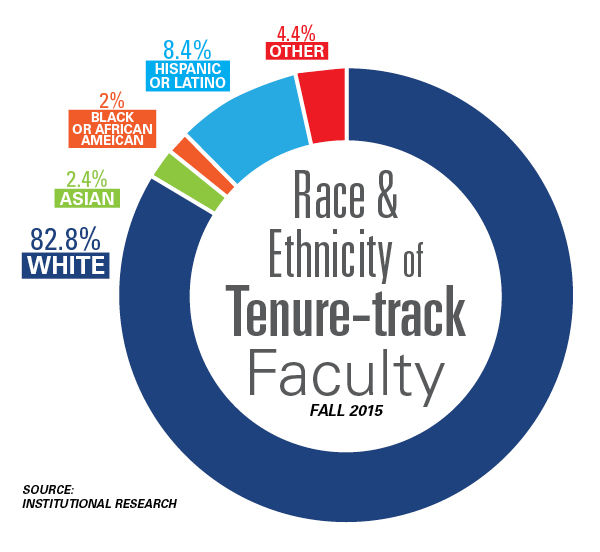Faculty continues to lack diversity

Diversity
St. Edward’s University faculty is getting more diverse: combined non-white faculty increased by 1.7 percent, according to data from Institutional Research.
In January 2015, Hilltop Views used numbers from 2013 to report the race and ethnicity of the full-time faculty across campus. 84.7 percent of the faculty were white. That number ticked down to 82.8 percent for the Fall 2015 semester.
There are 203 faculty members included in the percentages. Of that number, 168 are white, 17 are Hispanic or Latino, five are Asian and four are black or African American.
These numbers do not account for adjunct faculty.
The 2014-15 student population shows a 48 percent enrollment of minority students, according to the facts and figures on St. Edward’s website.
So why isn’t the faculty as diverse as the students they teach?
“One of our goals as educators is really to provide students with an educational experiences that are sensitive to their cultural experiences,” said Kelly Green, co-chair of the Faculty Diversity Committee. “From that standpoint, having a diverse faculty is very important.”
The Winter 2016 edition of the St. Edward’s University Magazine highlights a diverse faculty. However, the magazine points out of the 471 total faculty members at St. Edward’s, 14 states and 38 countries are represented.
There is no mention of race or ethnicity.
Mischelle Diaz, director of communications, says the figure was no in response to Hilltop Views’ report in 2015, but to point out changes at the university over the past five years.
“It’s just one data point, certainly not the conclusive diversity point,” Diaz said.
The university published a video called “On the Rise: St. Edward’s University” in October. In the video, the same numbers about diverse faculty are used.
Hilal Yilmaz, assistant professor of economics, was in the video discussing diversity.
“I was given a script and because I was representing the international faculty, my script was focused on geography,” she said. “I believe the diversity in faculty is increasing, but has a long way to go.”
Yilmaz would go on to say the hiring of new faculty is a slow process and hiring a diverse group of faculty members is an important issue to focus on.
Michelle Robertson is the other co-chair of the Faculty Diversity Committee. She warned not to be overly optimistic, and that the data could be misleading because of the small sample sizes.
A more diverse faculty may be seen in the future because of changes to how faculty members are hired, Green said. These changes happened in 2014.
“One of the things we did as a committee a couple years ago was pull together a list of resources to help the deans when they do start recruiting for positions,” Green said. “There are some that are general outreach resources, and some that are by discipline,” referring to the traditionally minority-oriented professional organizations who are now being more actively courted while looking to source professorial candidates.
Students have noticed the lack of diversity of their professors.
“St. Edward’s prides itself on trying to be more diverse,” said Stephanie Downs, social justice events coordinator for the Multicultural Leadership Board. Downs indicated that a more diverse faculty could only be a benefit to the students. “Everyone has a different identity, everyone brings something to the table. That’s what the world is like.”
Members of the Faculty Diversity Committee brought up the idea of the university creating a new position that specifically focuses on a more diverse faculty. This position would have the administrative power to match the scale of the issue, Robertson said.
“What we’re seeing in some other institutions is that they’re starting to develop or establish an office of diversity and equality or an administrative role that’s focused on diversity,” Green said. “Those positions at other institutions are really starting to spearhead efforts, that, right now, a lot of other administrators or faculty members, are really driving.”
If an office of diversity is created at St. Edward’s, it would send a clear message to the community: “There’s a deep and meaningful commitment to increasing diversity and inclusion on campus,” Robertson said.
The Faculty Diversity Committee is working on new efforts to ensure that it finds issues that might not be visible from the surface so that change can happen.
“Even if we all agree something needs to happen, something needs to change,” Green said. “It’s a multiple-year process.”






